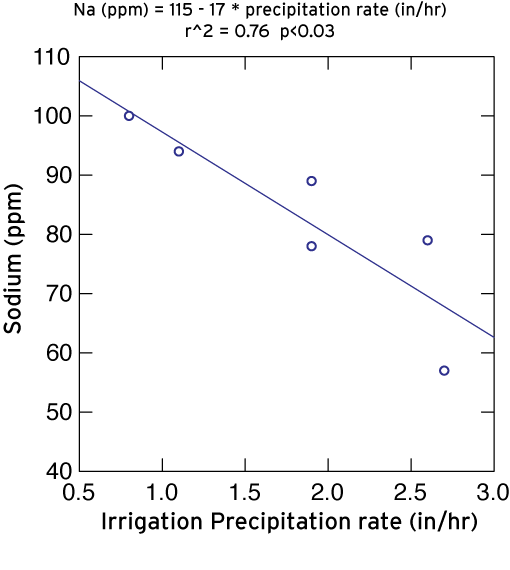Soil
Evaluation of leaching tactics
Managing soil salts is a challenge wherever rainfall is limited and infrequent. That is why Patty Reedy and Bruce Williams, CGCS at Los Angeles Country Club took time several years ago to study leaching tactics to refine the process to a science. In their 2008 study on LACC's USGA spec, A4 bentgrass greens, they leached test greens for 3.75 hours and generated the following results:
- The reduction in salinity was the same (about 20%), whether the drains were left open during leaching or they were closed during the initial period of the leaching event followed by opening the drain once the root zone was saturated.
- When catch cans were used to evaluate the precipitation rates on different areas of the test greens, they found a range between 0.8 in/hr (20 mm/hr) and 2.7 in/hr (69 mm/hr). Although this range is very wide, we have seen similarly wide ranges in precipitation rates in other locations, as shown in a recent study on irrigation distribution and turf disease. This variability is at least partly due to general problems in irrigation design that result in uneven distribution patterns (see the PACE Insights, Issues in irrigation: the uniformity myth (254 KB pdf document).
- The more than three-fold range in precipitation rates had a significant effect on the pre-leaching levels of sodium detected in the soil, with the lowest precipitation areas showing the highest sodium levels, as shown in the graph on the right.
- After leaching, the differences in sodium that were a result of differences in precipitation rate had vanished. In other words, leaching produced the desired effect of not only lowering soil salts in all areas of the green, but of also removing the variability in salt accumulation caused by variable precipitation rates.
Principal investigators: Bruce Williams, CGCS and Patty Reedy, The Los Angeles Country Club, Los Angeles, CA.
The full print version of the report is available at Evaluation of leaching methods on USGA specification greens (611 KB pdf document).
Leaching evaluation conducted at Mission Viejo Country Club
Summary:
Kevin Hutchins, superintendent at Mission Viejo Country Club (Mission Viejo, CA) evaluated the impact of leaching poorly draining fairways that have low saturated hydraulic conductivity. The fairway soils run as high as 20% clay and 30% silt. Estimated saturated hydraulic conductivity is less than 0.4 inches per hour (1 cm/hr). Irrigation was applied slowly in attempt to match soil infiltration rates. Fifteen minute irrigation cycles were followed by two hour soaks over the course of three consecutive days. A total of 5 inches (13 cm) of water was applied. The results showed that leaching reduced soil salinity and nitrogen by about 20%, while chloride was reduced by 40%. Sulfur and sodium levels were slightly reduced, but not significantly. This study illustrates the difficulty encountered when attempting to leach soil salts from soils that have low saturated hydraulic conductivity.
Principal investigators: Kevin Hutchins, Mission Viejo Country Club, Larry Stowell, Ph.D. and Wendy Gelernter, Ph.D., PACE Turf
Posted 9/1/08
Using virtual irrigation to forecast disease
Poster presentation at the 2008 American Phytopathological Society meetings, July 26 - 30, Minneapolis, MN.
Authors: Larry Stowell and Wendy Gelernter (PACE Turfgrass Research Institute) and Frank Wong and Chi-Men Chen, University of California Riverside
Click here to view the poster (130 KB)
Summary: Recent research suggests that soil moisture impacts the severity of turf diseases such as anthracnose caused by Colletotrichum cereale, Pythium root dysfunction caused by Pythium volutum, gray leaf spot (GLS) caused by Magnaporthe grisea and brown ring patch (BRP) caused by Waitea circinata var. circinata. The virtual irrigation audit, a simple computer model that predicts the size and location of both wet and dry areas on golf course turf, was designed to provide diagnosticians and turf managers with a precision turfgrass management tool for disease and soil moisture management. In this study, the virtual audit was successfully used to describe the occurrence of GLS and BRP on golf course turf.





